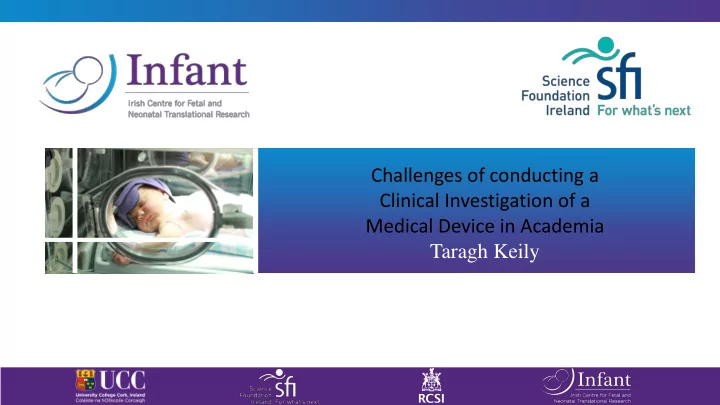

Challenges of conducting a Clinical Investigation of a Medical Device in Academia Taragh Keily
Contents Background • ANSeR project and ANSeR Clinical Investigation • Investigational Medical Device: The ANSeR Software System Product development (prototype to investigational medical device) • Intended use & Device Classification • Is a pre-market Clinical Study necessary? Is it a Clinical Investigation? • Medical Device Directive and meeting the “essential requirements” • Quality Management System & Risk Management During the Clinical Investigation - ISO14155 • Device feedback, Device Modifications , Device Defects, Adverse Event reporting • Investigator’s Brochure and Risk Assessment
A Multicentre Clinical Evaluation of a Neonatal Seizure Detection Algorithm • Product development to bring the ANSeR Algorithm to the cot-side Complete • Strong clinical need for a neonatal Seizure Detection Algorithm • Phase 1 : Multicentre observational study evaluating usual clinical practice for seizure diagnosis. Data analysis ongoing • Phase 2 : Clinical Investigation: Recruiting “A multi-centre, randomised, controlled, clinical Investigation of a standalone decision support Algorithm for Neonatal Seizure Recognition”
ANSeR Clinical Investigation recruitment rate per month Total Recruitment 139 (N=264) Neonates • Over 50 % of patient population enrolled (March 2016)
Participating hospital sites 1. Cork University Maternity Hospital 2. University College London Hospital 3. Rotunda Hospital 4. Great Ormond Street Hospital 5. The Royal London 6. Barts Hospital London 7. Karolinska Institute, Sweden 8. Utrecht Medical Centre, Netherlands
EU Competent Authority -Regulatory Approval/Notifications • Ireland • Healthcare Products Regulatory Agency (HPRA) • Sweden • Medicinal Products Agency ( MPA ) • UK • Medicines and Healthcare products Regulatory Agency (MHRA) • Netherlands • Dutch Health Care Inspectorate (DHCI)
ANSeR Core Team at UCC Prof Liam Marnane, Prof Geraldine Boylan , Dr Janet Rennie, Dr Gordon Lightbody
ANSeR product development • Software Development to bring ANSeR to the cot side. • Development of Real Time User Interface • Industry Partner: EEG file acquisition • International standards for ANSeR Development & regulatory compliance. • ISO13485: Medical Device Quality Management Systems • EC62304:2006 - Medical device software - Software life cycle processes . Commercialization pathway • ISO14971 2012: Medical devices - Application of risk management to medical devices
Device Description • The ANSeR Software (supplied by UCC) is installed on a hospital laptop for the Clinical Investigation • The hospital laptop is connected to the Nihon Kohden EEG Acquisition System. • The NK 1200/EEG is used within it’s CE marked ‘Intended Use’.
ANSeR Software System Device Classification • Intended use: “ The intended use of the ANSeR Software System is either as a real-time decision support tool to assist in the diagnosis of seizures in neonates ≥36 GA, or as a standalone review tool to analyse seizures in a post-hoc environment. The ANSeR Software System is intended to provide a reliable, effective, objective and intuitive means of identifying EEG seizures in the neonate.” • Class 2a Investigational Medical Device under Medical Device Directive 93/42/EC as amended • ‘Standalone software’ per MEDDEV 2.1/6.
Is it a Clinical Investigation? • SUMMARY- Purpose of Clinical Evidence (CER + Clinical Data) • Clinical Evidence is required to demonstrate compliance with the MDD Essential Requirements. • If the Essential Requirements cannot be met using the existing Clinical Evidence, then a new Clinical Investigation is probably required to fill in the knowledge gaps. • Clinical Evidence is also required to support adoption of new technologies
Inves estigational m medical de devi vice ( e (ISO14155) • medical device being assessed for safety or performance in a clinical investigation NOTE 1 This includes medical devices already on the market, that are being evaluated for new intended uses, new populations, new materials or design changes. • An investigational Medical device must meet all the applicable essential requirement of the MDD apart from those under investigation.
Technical Documentation Generated to support regulatory submissions demonstrate compliance with international standards
During the Clinical Investigation • User feedback is captured through the eCRF. • Device deficiencies “ inadequacy of a medical device with respect to its identity, quality, durability, reliability, safety or performance. NOTE Device deficiencies include malfunctions, use errors, and inadequate labelling.” • Adverse Event and Serious Adverse Event Reporting • Weekly reporting to CAs
ISO14155 device defects • adverse device effect ADE • adverse event related to the use of an investigational medical device NOTE 1 This definition includes adverse events resulting from insufficient or inadequate instructions for use, deployment, implantation, installation, or operation, or any malfunction of the investigational medical device. NOTE 2 This definition includes any event resulting from use error or from intentional misuse of the investigational medical device. • unanticipated serious adverse device effect USADE • serious adverse device effect which by its nature, incidence, severity or outcome has not been identified in the current version of the risk analysis report • NOTE Anticipated serious adverse device effect (ASADE) is an effect which by its nature, incidence, severity or outcome has been identified in the risk analysis report .
Orchestrated Timelines? Submit Protocol/ Software Change! Regulatory/EC Review Site Contracts Time…
Main challenges • Terminology in standards, regulations aimed at industry manufacturer • Some “grey areas” for academic studies. • Understanding of device development process, essential requirements. • Developing a QMS and execution.
Thank you Questions
Recommend
More recommend